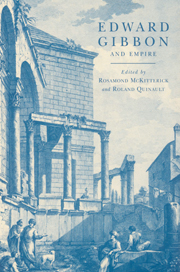Book contents
- Frontmatter
- Contents
- List of contributors
- Preface
- List of abbreviations
- Introduction
- 1 Gibbon and the later Roman Empire: causes and circumstances
- 2 Gibbon and Justinian
- 3 Gibbon and the middle period of the Byzantine Empire
- 4 Byzantine soldiers, missionaries and diplomacy under Gibbon's eyes
- 5 Gibbon and the later Byzantine Empires
- 6 Gibbon and the Merovingians
- 7 Gibbon, Hodgkin, and the invaders of Italy
- 8 Gibbon and the early Middle Ages in eighteenth-century Europe
- 9 Gibbon and the ‘Watchmen of the Holy City’: revision and religion in the Decline and fall
- 10 Gibbon and international relations
- 11 Gibbon's Roman Empire as a universal monarchy: the Decline and fall and the imperial idea in early modern Europe
- 12 The conception of Gibbon's History
- 13 Winston Churchill and Gibbon
- Epilogue
- Index
13 - Winston Churchill and Gibbon
Published online by Cambridge University Press: 02 December 2009
- Frontmatter
- Contents
- List of contributors
- Preface
- List of abbreviations
- Introduction
- 1 Gibbon and the later Roman Empire: causes and circumstances
- 2 Gibbon and Justinian
- 3 Gibbon and the middle period of the Byzantine Empire
- 4 Byzantine soldiers, missionaries and diplomacy under Gibbon's eyes
- 5 Gibbon and the later Byzantine Empires
- 6 Gibbon and the Merovingians
- 7 Gibbon, Hodgkin, and the invaders of Italy
- 8 Gibbon and the early Middle Ages in eighteenth-century Europe
- 9 Gibbon and the ‘Watchmen of the Holy City’: revision and religion in the Decline and fall
- 10 Gibbon and international relations
- 11 Gibbon's Roman Empire as a universal monarchy: the Decline and fall and the imperial idea in early modern Europe
- 12 The conception of Gibbon's History
- 13 Winston Churchill and Gibbon
- Epilogue
- Index
Summary
Winston Churchill decided to read The decline and fall of the Roman Empire at the age of twenty, in 1895. At that time he was a cavalry subaltern at Aldershot and he thought it would be more agreeable to read Gibbon than to pile up statistics. His resolve was strengthened by the advice of his old headmaster at Harrow: ‘Gibbon is the greatest of historians, read him all through.’ Churchill began reading Dean Milman's eight-volume edition of Decline and fall in the summer of 1896. He was then posted, with his regiment, to Bangalore, in India, where he read Gibbon lying on his champoy during the after lunch siesta:
I was immediately dominated both by the story and the style. All through the long listening middle hours of the Indian day, from when we quitted stables till the evening shadows proclaimed the hour of Polo, I devoured Gibbon. I rode triumphantly through it from end to end and enjoyed it all. I scribbled all my opinions on the margins of the pages and very soon found myself a vehement partisan of the author against the disparagement of his pompous-pious editor. I was not even estranged by his naughty footnotes. On the other hand the Dean's apologies and disclaimers roused my ire.
Churchill also read Gibbon's autobiography, before concluding what he described as ‘a delightful companionship of six months with Gibbon’. He then moved on to Macaulay, but soon concluded that he was ‘not half so solid as Gibbon’.
- Type
- Chapter
- Information
- Edward Gibbon and Empire , pp. 317 - 332Publisher: Cambridge University PressPrint publication year: 1996
- 1
- Cited by



